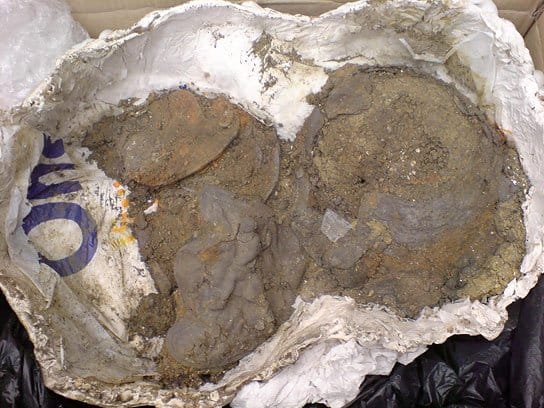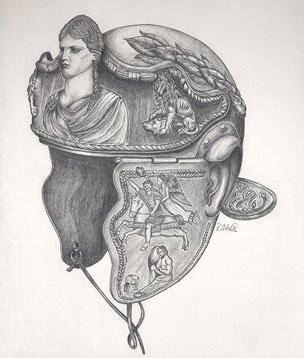
In the early 2000s, amateur archaeologists in the UK dug up a large and extremely rusted metal object somewhere in Leicestershire. It certainly didn’t look like much. However, this would prove to be one of the most important archaeological finds made this century in Britain.
The artifact, still encased in the soil block in which it was found, was examined by experts at the British Museum, who with their trained eyes found it was an ancient Roman helmet.
This was no ordinary foot-soldier headgear. As conservators painstakingly peeled off the many layers of rust and soil, they realized this was a Roman cavalry helmet (equites) of extraordinary craftsmanship, etched with intricate decorations made of gold and silver.
After two decades of painstaking restoration, the artifact, now known as the Hallaton Helmet, has been restored to marvelous condition. Initially described jokingly as a “rusty bucket”, the Roman helmet has now regained a semblance of its former glory. It is set to be displayed in the U.K., offering the public a rare glimpse into Roman military history and craftsmanship.
Restoring the past


The helmet was discovered alongside thousands of Iron Age and Roman coins and pig bones within what is believed to have been a shrine from around 43 A.D. Its intricate design, adorned with decorations made of precious metals, suggests it belonged to a high-ranking Roman cavalry officer.
This decoration showcases a wreath symbolizing military victory and a scallop-shaped browguard displaying a woman’s bust surrounded by animals. The cheekpieces portray a Roman emperor riding a horse with the goddess Victory flying behind him, and beneath the horse’s hooves lies a cowering figure, possibly a native Briton.

The cumbersome restoration process involved 3D scanning the fragments to facilitate a careful reconstruction. Each fragment, from the helmet bowl to the seven cheekpieces, was painstakingly pieced together by conservators. They managed to restore the helmet to 80% of its original structure.

Based on this restoration, experts began work on a replica. Rajesh Gogna, a silversmith and senior lecturer at De Montfort University, took on the challenge of recreating the helmet using 21st-century methods. Armed with 3D scans of the original fragments, Gogna and his team created a digital model of the helmet. They then used this model to produce a resin replica, which was electroformed, silver-plated, and gilded to mimic the original’s appearance.

Another replica was made by Francesco Galluccio, an Italian archaeologist and renowned replica-maker, who chose a more traditional approach. Using techniques that would have been familiar to Roman artisans, Galluccio forged an iron core for the helmet and hammered brass sheets to create the decorative outer layer. His interpretation of the helmet’s motifs, while slightly different from Gogna’s, was grounded in extensive research and parallels from Roman art.

The cavalry helmet was not alone. Among the artifacts, archeologists recovered a trove of over 5,000 Iron Age and Roman coins, silver bowls, and hundreds of animal bones linked to ceremonial feasts, now known as the Hallaton Treasure. The helmet’s intricate designs—featuring a female figure flanked by lions, griffins holding an amphora, and a laurel wreath—were recreated using computer-aided design (CAD). Yet, Gogna also incorporated handcrafted elements, such as brass rivets and pins, to stay true to the original’s construction.
Echoes of Roman Britain
The story of the exquisite Roman helmet is still shrouded in mystery. Perhaps the high-status man who served in the Roman cavalry buried it at his local shrine as a gift to the gods after returning home from a successful military campaign. Or, perhaps it was a diplomatic gift of sorts to a supportive local population.
Others suggest the helmet is a spoil of war, captured in battle. That’s not a far-fetched conclusion since the Roman Empire was still in its early stages of conquering Britain when the helmet was buried. In AD 43, the Roman emperor Claudius launched an invasion of Britain, facing stiff resistance from local tribes. Over the next 45 years, the Roman army gradually extended its control over much of present-day England and Wales and ventured into territory now in Scotland, where Hadrian’s Wall, and later the Antonine Wall, would mark the empire’s northernmost frontier.
The Romans would rule over these lands for nearly three centuries before Britain was abandoned by a crumbling empire on the edge of disintegration.

The refurbished headgear is now displayed at the Harborough Museum in Leicester, located about 100 miles northwest of London. The two replicas, now displayed alongside the original fragments at the same museum. The replica project was made possible thanks to funding from a number of local charities and groups as well as the district council.


